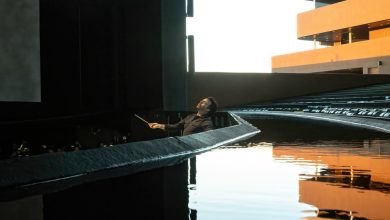In ‘Oppenheimer’ and ‘The Zone of Interest,’ We Hear What We Are

Humans have spent much of history coming up with novel ways to exterminate one another, but the defining feature of modern violence is its technologization. With a chilling practicality, systems and tools designed to enhance productivity can also separate the killers from the killing, stifling pesky human impulses like empathy and conscience. But a bomb has only one purpose. So does a concentration camp.
Both “Oppenheimer” and “The Zone of Interest” tangle with the psychology involved in creating highly efficient killing machines. Choosing to center on people who make and deploy lethal tools at roughly the same historical moment — an era of unprecedented technological advancement — the filmmakers faced a challenge. Viscerally depicting the psychic gulf between methods of massacre and their creators is not simple in a medium like film. Cinema tends to enforce closeness between us and the characters; we see the wrinkles in their skin, understand them as humans, feel their emotions and project our own onto them. To portray cognitive dissonance requires something unexpected.
The solution, for both of these movies, lay in the second most powerful tool available to filmmakers: sound. Not the music, but the knocks and steps and whizzes and shrieks. Generally we’re used to the sound in a film supporting the images. In both “Zone” and “Oppenheimer,” though, sound plays against image in a way that draws attention to itself, disconcerting the audience. Both films are up for Academy Awards in multiple categories, including best picture, which means their nominations for sound design are easy to overlook. But the way each uses sound is striking. It’s engineered as an unsettling agent, a means to carry moral weight from the screen to the audience on a level that approaches the subconscious.
THE DIRECTOR OF “OPPENHEIMER,” Christopher Nolan, has long played around with sound in his films, which are often very loud and propelled by an intense, driving score. (Watching one of his films can feel at times as if you’re immersed in one very, very long montage.) Nolan also prefers not to rerecord actors’ dialogue, leaving them mixed into the sound as they were recorded during the performance, which can make them a little hard to hear. He knows, and he doesn’t mind.
“Oppenheimer,” with sound design by the frequent Nolan collaborator Richard King, is no different. Most of the three-hour movie, about the creation of the atomic bomb, is guys in suits, talking about fission and geopolitics and other brainy matters over a pulsating score by Ludwig Goransson. But right around the two-hour mark, something startling occurs.
If you’ve seen the film, you know the moment. The scientists of the Manhattan Project and select military officials have gathered in the New Mexico desert for the Trinity test, the first trial detonation of a nuclear bomb. It is the wee hours of July 16, 1945. If the test goes well, two more bombs will be deployed in mere weeks to kill hundreds of thousands of Japanese — and, the scientists hope, end the war.





